If you have your sights set on a Grand Fondo or a charity century (100 miles in one day), your training program should focus on the essential aspects of fitness: cardiovascular endurance, muscular strength/endurance and flexibility.
All three need to be progressively challenged to ensure you're ready, but your starting point depends on your current conditioning, your previous riding experience and your available time.
Be sure to consult with your doctor before starting any new training routine.
Training Plan for Endurance Cycling
On a long hill or mountain pass, those seemingly endless climbs can test the strongest legs. Keeping a strong, positive mindset can make a big difference. Breathe, stay in the moment, relax and slow down if you need to. But no matter how positive you are, being physically prepared is the key to not just finishing the ride, but to feeling great as well.
Cardiovascular Conditioning
If you're training for a Grand Fondo or a mountainous century, you are going to need to spend a significant amount of time outside climbing. If you have little access to hills/mountains where you live, then training in strong headwinds on flat roads can work quite well too. If you don't live in an area that has strong winds, working on an indoor trainer with increased resistance or using the hardest gear on your road bike is also an option for increasing intensity.
If your goal is to ride a century, here are some training suggestions to help you prepare using indoor or outdoor training. As you'll see, distance is built for the first three weeks of the month and decreased the last week of the month for recovery.
For indoor riding, you can use either a stationary bike or indoor cycling classes 2-3 times per week along with two longer weekend rides.
Cardiovascular Training: Month 1
Follow this same scheme for the next two months with increases in mileage on Tuesdays, Wednesdays, Saturdays and Sundays:
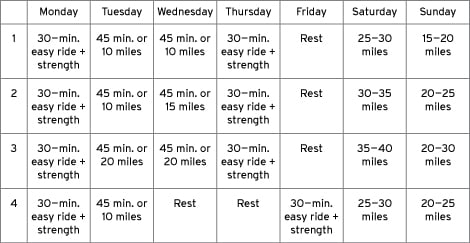
Month 2: In your second month of training, continue to increase the mileage of the indoor rides and increase your weekend distance to 35 miles, building to 45-50 miles by the third week of the second month.
Month 3: For your third month, start to build from 45-50 miles and up to 65-70 miles by the third week.
Before your event: The weekend before your event, cut your weekend ride mileage back to closer to 40-45 miles. Two days before your event, do an easy 45-minute recovery ride (conversational pace), and leave the day before the race as a rest day.
Strength Training for Endurance Cycling
Cycling is predominately a lower-body sport, so it's easy to focus your strength work on those muscles. However, your upper body muscles support your torso, and having a strong core can help prevent back pain and fatigue. Strong arms and shoulders can help you ride strong on long, flat roads, while strong core muscles fuel strength for steep climbs.
This strength program should be performed twice a week throughout your training. Mondays and Thursdays are ideal, but if this doesn't fit your schedule, just train twice a week on non-consecutive days and you'll be in good shape.
Warm up with 5-10 minutes of light cardio. Do these exercises in the following order:
Dumbbell Goblet Squat
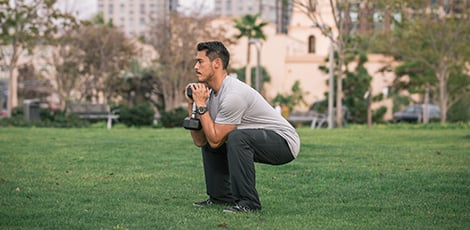
- Hold a dumbbell vertically (or use any weight) up against your chest.
- Position your feet a little wider than shoulder-width apart and turn your toes out slightly (the less mobile the hips, the more the toes will need to turn out).
- Drop your hips straight down toward the ground, keeping your chest open and shoulders anchored down and back.
- Pretend you are separating the ground with your feet and engage your glutes as you power back up to the starting position.
- Do 8-12 reps, for 2-3 sets with 60-90 seconds of recovery between each set.
Modification: This exercise can be performed as a body-weight squat (without the added weight), or as an assisted squat with a suspension trainer. If you are unable to perform this exercise as shown, remove the load and/or reduce your range of motion.
Rubber Resistance Bilateral Seated Row
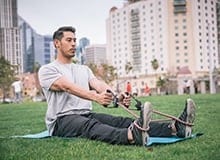
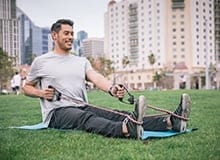
- Begin in a seated position with legs outstretched and the band wrapped around your feet.
- Exhaling, bend your right elbow and pull the handle to the side of your ribcage, driving your elbow straight behind you.
- Maintain perfect posture while squeezing between your shoulder blades. Slowly return your hand to the start position.
- Alternate each side, taking one second to pull your hand in and two to three seconds to extend your arm forward.
- Keep your shoulders pressed down away from your ears and your chest open. As you pull your elbow back, rotate your upper back.
- Do 10-12 reps for 2-3 sets with 30-60 seconds recovery between each set.
Dumbbell Split Squat
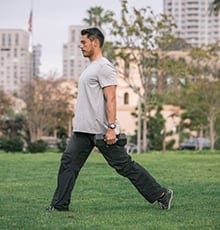
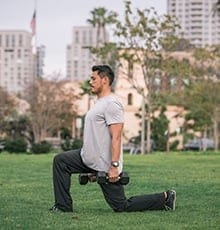
- Begin with one foot out in front of you with the shoulders in line over the hips. Hold one dumbbell in each hand.
- Bending both knees, sink your hips and lower yourself until your back knee almost touches the floor.
- Maintain an upright posture and inhale as you lower slowly, with control. Exhale and push up to the start position.
- Keep your shoulders square and chest lifted.
- Do 8-12 reps each side for 2-3 sets with 30-60 seconds of rest between sets.
Push-Up to Side Plank
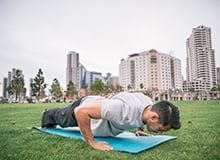
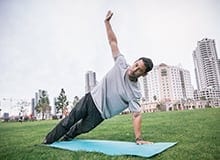
- Perform a push-up (on knees or toes).
- Next, rotate your body to a full-body side plank: Rotate your ankles so you're resting on the side of your feet and hips are stacked vertically, then lift one hand off the floor and reach toward the ceiling or sky.
- Pause for 4-5 seconds then return to the start position. Perform another push-up, then do a side plank on the other side.
- Keep your spine lengthened throughout the entire exercise by maintaining a contraction of the abdominals.
- Do 8 push-ups with 4 side planks each side. Recover for 30-60 seconds, then repeat for another 2-3 sets.
Dumbbell Bent Legged Dead Lift
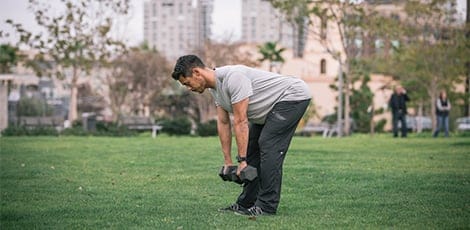
- Begin standing with feet hip-width apart and dumbbells in front of the body.
- Hinge forward at the hips, driving the hips back behind the feet, while at the same time bending the knees.
- Inhaling, hinge forward until the spine is almost parallel with the floor, lowering the dumbbells (or Kettlebells) toward the floor.
- Exhale and drive up through your hips and knees to the starting position.
- Brace your abdominals strongly, maintaining a lengthened spine. Don't allow your spine to flex or become rounded.
- Do 8-12 reps with 60-90 seconds of rest in between for 2-3 sets.
Glute Bridge
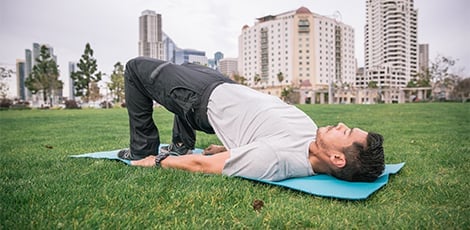
- Begin lying on your back with your feet hip-width apart and knees bent.
- Exhale while pressing your heels into the floor, and drive your hips up until you are resting on your shoulders.
- Slightly lift your toes off the floor. Inhale and lower your hips to the starting position.
- When at the top of the bridge position, tuck your tailbone under so that you don't excessively arch your lower back.
- Do 8-12 reps with 30 seconds of rest between for 1-2 sets.
Bird Dog
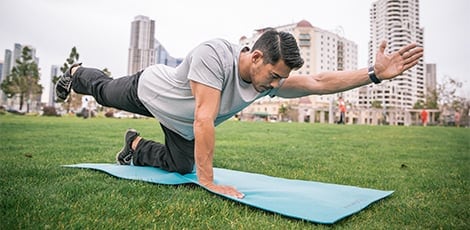
- Begin in a tabletop position with hands under the shoulders and knees under the hips.
- Exhale and raise your right arm and your left leg until they are lined up with your spine. Brace your abdominals. There should be no movement in the lower back at all.
- Keep your neck neutral without looking up or down. Keep the whole of the spine aligned, from the top of your head to your heel.
- Hold this position for 20-30 seconds and maintain a natural breathing pattern.
- Slowly return to the start position, then repeat on the other side.
- Do 2-4 reps each side for 1 set. No rest between right and left sides.
Flexibility Training for Endurance Cycling
Because the hip, knee and ankle never move through a full range of motion in the pedal stroke, tightness is a major concern for anyone embarking on an endurance cycling event.
The stretches outlined here are designed to address the typical muscular tightness a cyclist may experience. The stretches will take no more than 7-10 minutes after your long rides. Consider these six stretches your essentials, but you may also want to add in some yoga or Pilates classes.
Supine Hamstring Leg Pull
- Lie on your back with left leg straight on the floor, then raise your right leg and wrap a towel or yoga strap around your right foot.
- Holding both ends of the towel or strap, and keeping your right leg straight, gently pull your leg toward your chest to stretch the back of your leg.
- Repeat on the other leg.
Figure-4 Hip Stretch
- Lying on your back, cross your right ankle above the left knee (not directly on top of the knee joint). Bend and lift your left leg toward your chest, while holding the back of the thigh with both hands. Keep your right foot flexed and your left foot relaxed.
- Gently encourage your right knee open as you pull the left leg toward you.
- Hold for 30 seconds before repeating on the other side.
Prone Cobra Torso Stretch
- Roll onto your belly and slide your elbows under your shoulders with your forearms on the floor.
- Push up and extend your chest away from the floor, stretching the front of your body.
- Hold for 30 seconds.
Side-Lying Quad and Hip Flexor Stretch
- Lying on your right side, propped on your right elbow, grasp your left ankle/foot and pull the ankle behind you while keeping your knees close together.
- You'll feel a stretch in the front of your hip and thigh.
- Hold for 30 seconds before repeating on the other side.
Butterfly Groin Stretch
- Sit with the soles of your feet together and knees bent and out to the side.
- Hold your feet and gently pull your body forward while keeping your back flat and encouraging your knees gently down.
- Hold for 30 seconds.
Seated Head Tilt Neck Stretches
- Sitting cross-legged, reach your right hand to the side away from you toward the floor.
- With your left hand gently tilt your head to the left, stretching the muscles in the right side of your neck.
- Hold for 30 seconds before repeating on the other side.
The nonprofit American Council on Exercise (ACE) educates, certifies, and represents more than 53,000 fitness professionals, health coaches, and other allied health professionals.
This publication is not intended to provide medical advice on personal health issues, which should be obtained directly from a physician.
